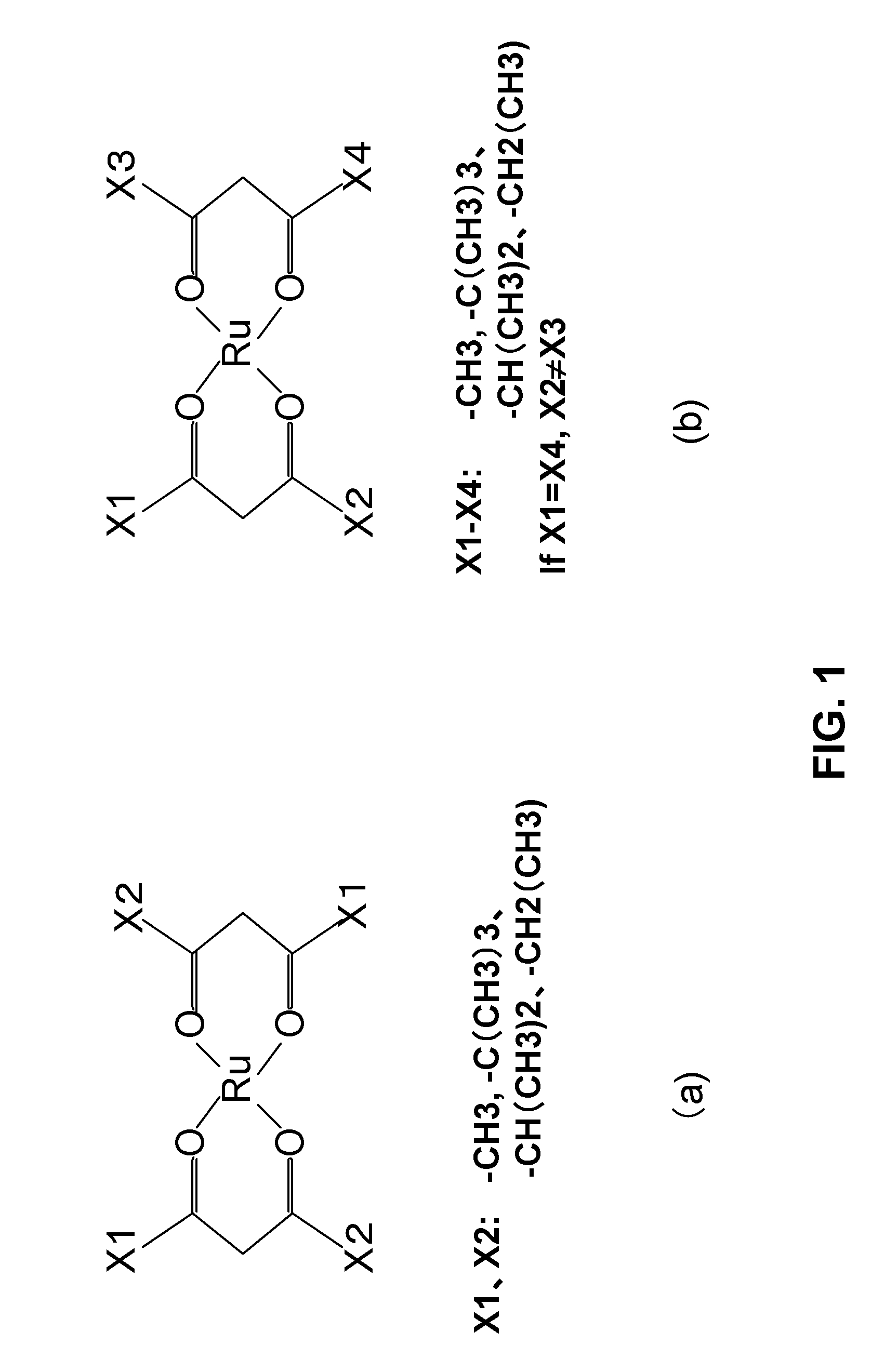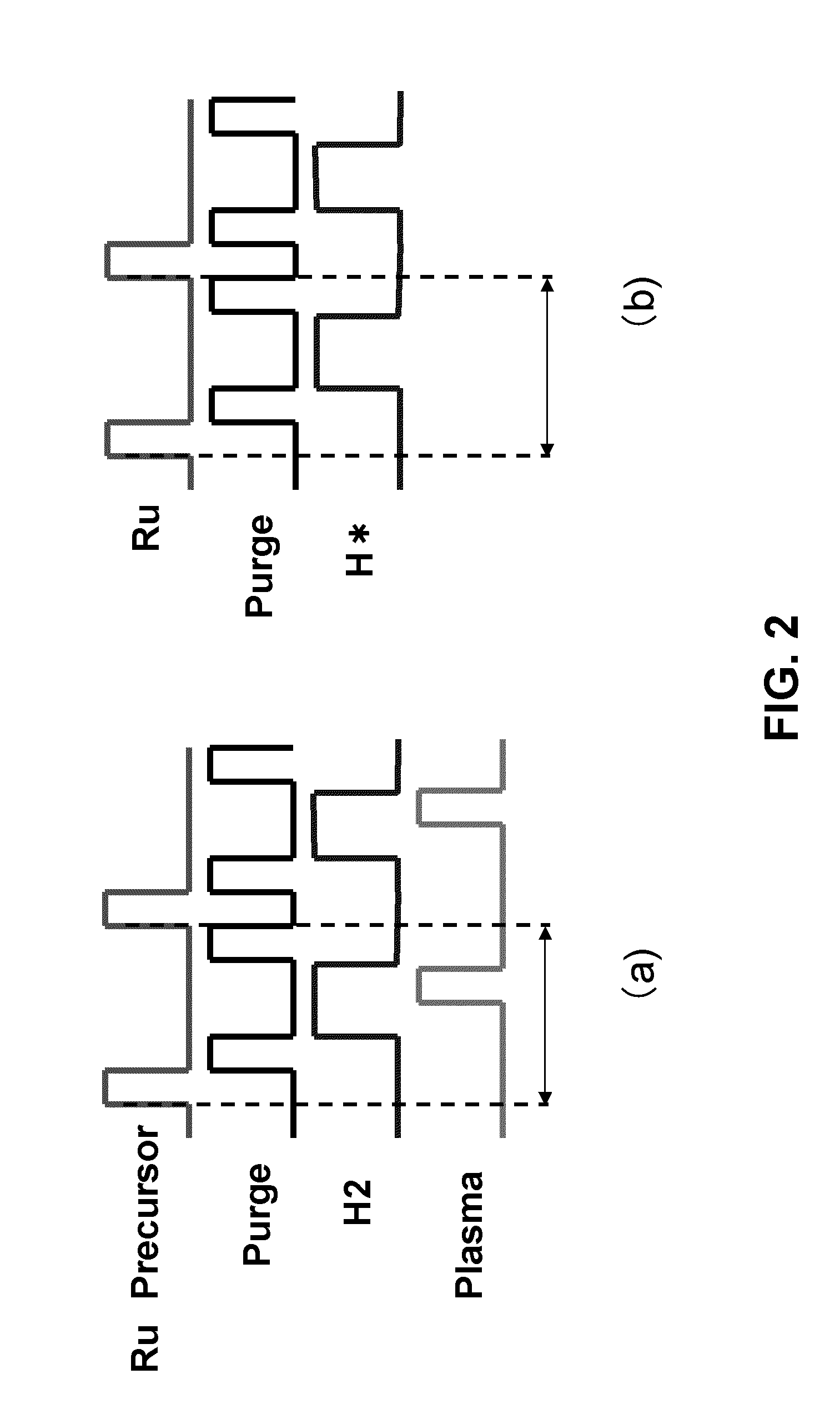METHOD FOR FORMING RUTHENIUM COMPLEX FILM USING Beta-DIKETONE-COORDINATED RUTHENIUM PRECURSOR
a technology of ruthenium complex and precursor, which is applied in the direction of coatings, layered products, chemistry apparatus and processes, etc., can solve the problems of present problems and partially exposed barrier films, and achieve the effect of reducing the resistivity of the obtained ruthenium film
- Summary
- Abstract
- Description
- Claims
- Application Information
AI Technical Summary
Benefits of technology
Problems solved by technology
Method used
Image
Examples
example 1
[0164]Application of a Ru film to semiconductor copper wiring using the process sequence shown in FIG. 2(a) is explained by using the schematic cross-section structure view in FIG. 3.
[0165]FIGS. 4(a) to (f) show a process for forming a Cu wiring by forming a Cu barrier film via dual damascene wiring and then forming a Cu seed layer, followed by Cu plating and Cu CMP. In FIG. 4(a), a via hole 106 is formed in an inter-layer insulation film 102 and a Cu barrier insulation film 103, and also a wiring trench 107 is formed in an inter-layer insulation film 104 and a Cu barrier insulation film 105, where all of the films are formed on a Cu lower-layer wiring 101. These via hole 106 and wiring trench 107 together constitute a Cu embedding range for dual damascene. In FIG. 4(b), a TaNxCy film 108 is formed over this range for 50 cycles, or approx. 3 nm, using the atomic layer deposition method using TIMATA (Tertiaryamylimidotris(dimethylamido)tantalum) material and hydrogen plasma. This for...
example 2
[0171]Application of a Ru film to capacitor electrodes of a dynamic random access memory, among various semiconductor memory devices, is explained using the schematic cross-section structure views of capacitor electrodes shown in FIGS. 10(a) to (c).
[0172]FIG. 10(a) shows the condition before the lower-layer electrode of a memory capacity is formed in the manufacturing process for dynamic random access memory cells having laminated capacitor electrodes. A silicon substrate 212 is in a so-called active range, being surrounded by an element separation range 213. Numeral 214 indicates a diffusion layer, and a conductive contact plug 216 is formed on the diffusion layer. Numeral 217 indicates a gate electrode, while numeral 219 indicates a conductive wire that becomes a bit wire. Numeral 218 is an inter-layer insulation film, numeral 221 is formed by the insulation film, and numeral 222 is a hole opening provided in a manner allowing a capacitor to be formed. A conductive layer connectin...
example 3
[0175]Application of a Ru film to semiconductor copper wiring using the process sequence in FIG. 2(a) is explained using the schematic cross-section structure view shown in FIG. 3.
[0176]FIGS. 11(a) to (f) show a process for forming a Cu wiring by forming a Cu barrier film via dual damascene wiring and then forming a Cu seed layer, followed by Cu plating and Cu CMP. In FIG. 11(a), a via hole 106 is formed in an inter-layer insulation film 102 and a Cu barrier insulation film 103, and also a wiring trench 107 is formed in an inter-layer insulation film 104 and a Cu barrier insulation film 105, where all of the films are formed on a Cu lower-layer wiring 101. These via hole 106 and wiring trench 107 together constitute a Cu embedding range for dual damascene. In FIG. 11(b), a Ru film 113 is formed for 25 cycles, or approx. 1 nm, using a Ru forming method conforming to an embodiment of the present invention. The sequence in FIG. 2(a) is used to supply a Ru material constituting a Ru pre...
PUM
| Property | Measurement | Unit |
|---|---|---|
| Thickness | aaaaa | aaaaa |
| Thickness | aaaaa | aaaaa |
| Nanoscale particle size | aaaaa | aaaaa |
Abstract
Description
Claims
Application Information
 Login to View More
Login to View More - R&D
- Intellectual Property
- Life Sciences
- Materials
- Tech Scout
- Unparalleled Data Quality
- Higher Quality Content
- 60% Fewer Hallucinations
Browse by: Latest US Patents, China's latest patents, Technical Efficacy Thesaurus, Application Domain, Technology Topic, Popular Technical Reports.
© 2025 PatSnap. All rights reserved.Legal|Privacy policy|Modern Slavery Act Transparency Statement|Sitemap|About US| Contact US: help@patsnap.com



